Tope are one of our hardest fighting predators. They commonly grow over 40lbs and offer a turn of speed and line stripping power that is hard to rival. And from the boat they can be available in big numbers, with some western facing coasts giving the opportunity of 30 to 40 fish per day.
Season
Offshore tope normally arrive in the mid-April period and increase in numbers through May, but the peak of the season is June for inshore action before the tope gradually thin out as they move offshore, though fish can still be caught right through to November nowadays, again, especially in the west of the country.
Tope to about 25lbs are often referred to as pack tope, as they often group up together. However, the bigger 30lb plus fish and especially the bigger females, are usually only found with the pack tope during May. By June, the bigger tope will filter away from the main packs and frequent ground well away from the main numbers.
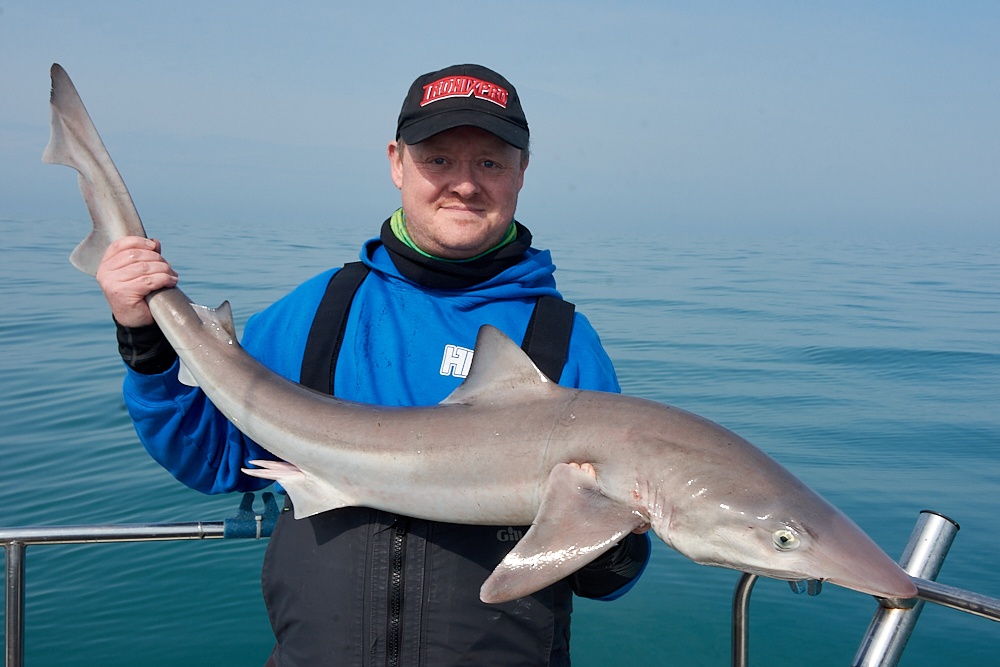
Habitat
They are found throughout the UK and Ireland with the top areas being The Wash, Thames Estuary, the English Channel coast, Devon and Cornwall, throughout Wales, the Northwest of England and right up the west coast of Scotland. They are also found throughout Ireland with the Wicklow coast, Waterford, Cork, Kerry, Galway, Mayo, and Donegal giving consistent returns.
They are an adaptable predator being found over clean sand targeting flatfish, gurnards and whiting, especially where there are lifting sandbanks, but also more broken ground, rougher reef ground and even rough peaky ground in deeper water. Prime areas are where sand meets rough reef ground, forming a definite broken edge the tope can hunt along. Inshore wrecks and even deep-water wrecks can often carry a few bigger tope, especially later in the season. They also run inside estuaries chasing school bass and flounder in the deeper main channels.
Weather and Tides
In shallower water, tope prefer periods of more settled weather with slight seas and gentle winds. If the weather cuts up, expect the tope packs to move out to deeper water. In water over 80-feet deep, they are less troubled by heavier sea swells, so continue to feed freely.
Overcast skies work in your favour when fishing in shallower water, as will some gentle breeze off the sea that ruffles the surface and cuts down on the light entering the water. In deeper water, the greyer skies are still best, but even bright daylight can still produce.
Tope will feed even on the smaller neap tides, but for peak catch numbers then the tides from mid-size rising towards the biggest spring tides of the tide cycle will produce the better fishing. One thing to bear in mind, though, is that as the overall numbers drop, the chances of a single bigger fish increase. This is because the bigger fish can’t and won’t compete with the faster pack tope for any available food. Expect bites to be slow over slack water, but after the first hour, when the tide starts to pick up speed then bites frequency increases quickly, peaking in the middle hours of the flood before decreasing again as the flow slackens towards high water. In many places, the ebbing tide will still produce good fishing.
Tackle
Over clean sand with minimal snags a lighter Tronixpro Banzai 12/20lb class boat rod is ideal, the longer rod being better as the action will be more suited to powerful fish that lunge on a short line. In deeper water, go for the heavier Banzai 20/30lb rod. A multiplier reel holding around 300yds of 20/30lb Tronixpro Blaze mono or X8 Power Braid with backing is ideal, though many anglers now choose one of the bigger 8000 sized fixed spool reels, such as the Tronixpro DV8 and load with 30lb braid. The fixed spool reel means you can cast a bait away from the boat and put your bait away from other competing anglers. Always use a heavier 60/75lb Xenon shockleader to avoid wear should the tope roll in the trace during the fight.
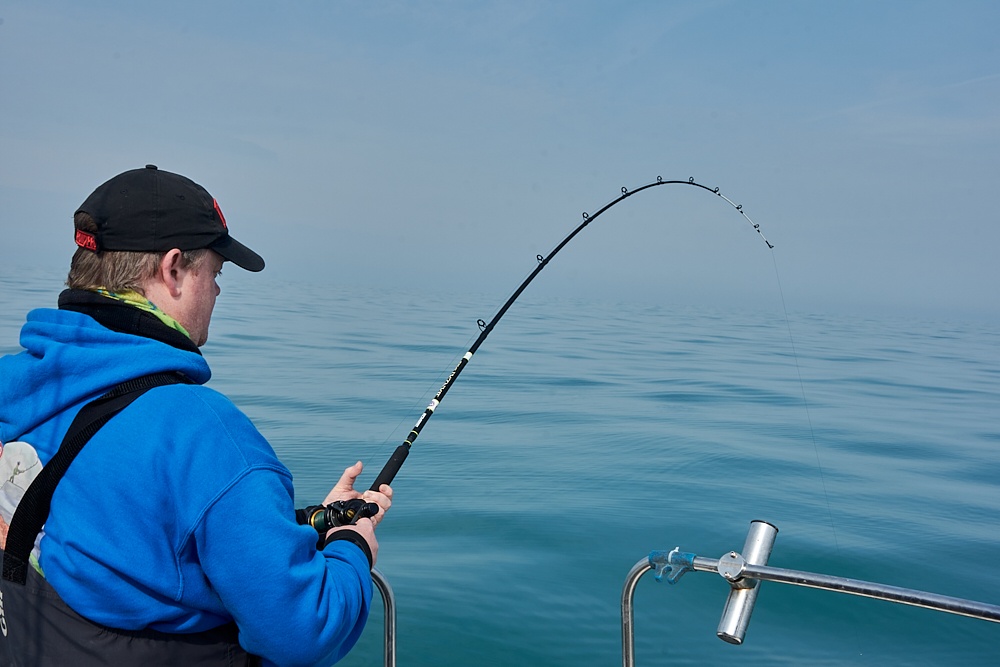
A simple flowing trace is the best rig. Onto the shock leader, slide on a Tronixpro Zip Slider, then a 5mm plastic bead and tie on a size 1/0 SS2 Rolling Swivel. To the size 1/0 rolling swivel, tie on 5ft of 75lb Xenon Leader and tie on another swivel. To the free eye of this swivel, crimp on 15-inches of 50lb Tronixpro Bite Nylon Coated Trace Wire. To the end of the trace wire, crimp on a size 6/0 Tronixpro Beast hook. Consider crushing the barb down on the hook. This makes removal so much easier, and you’ll lose no fish as a consequence.
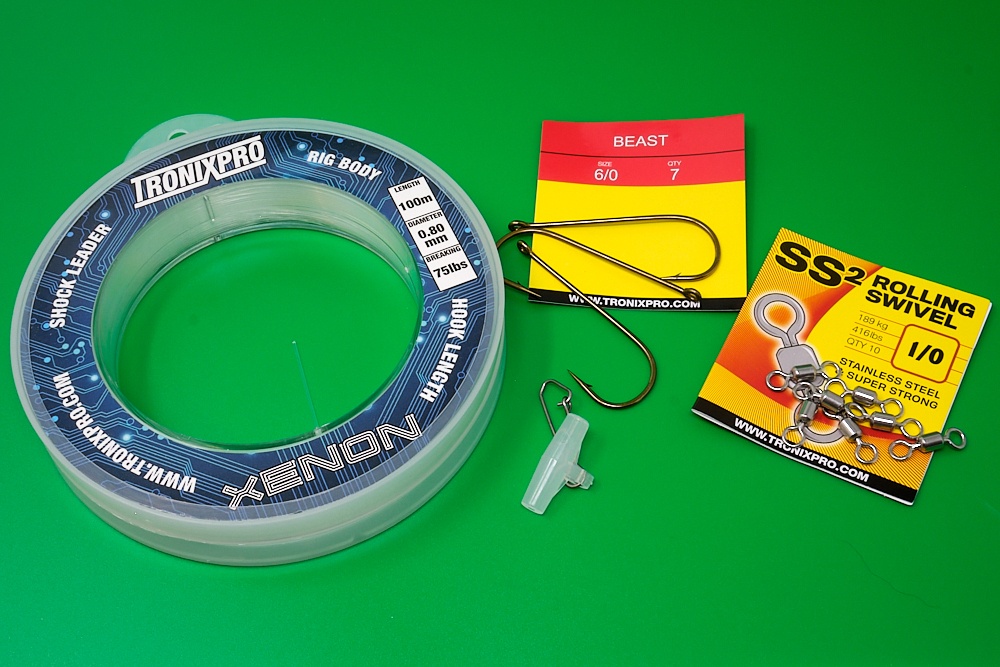
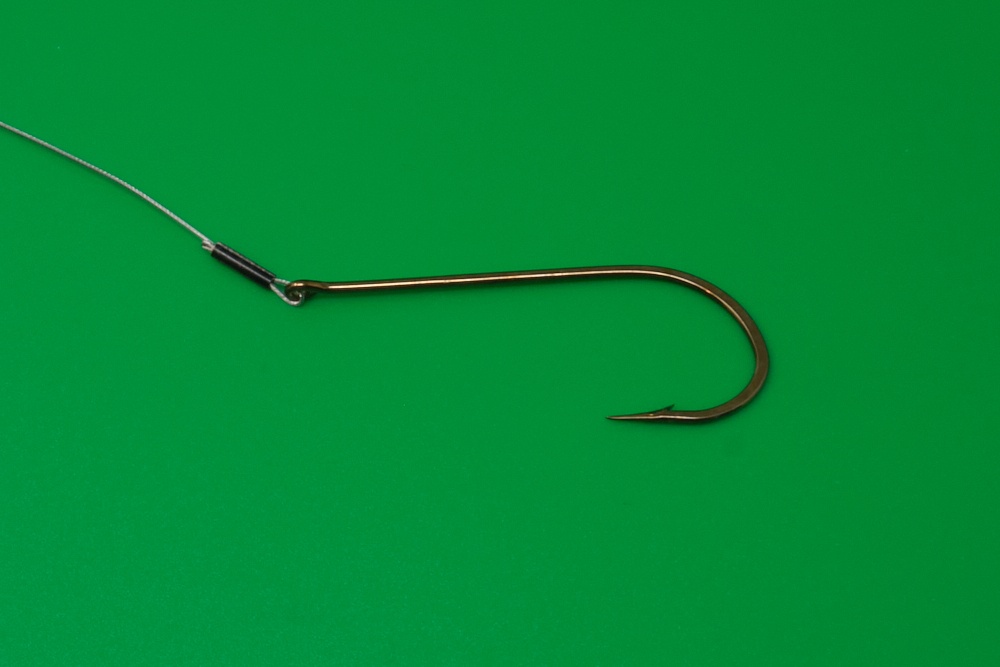
Some anglers use heavy 200lb mono for the hook length, but big tope can cut straight through this when they slew their head side to side at the boat side if being held too hard. Choosing a bronzed hook will see the hook rot away if a fish is lost in just a few days, making the use of heavy mono or wire immaterial. The hook is the weakest link, especially a de barbed one.
When casting away from the boat, hang the baited hook on the grip wires of the lead weight as it is the safest way to cast from the boat and the bait releases easily in flight to give a good presentation on the seabed.
Baits
The most used bait is mackerel, but the better baits are the more natural baits the tope are hunting such as a small or half whiting, half a dab, or a gurnard, but small coalfish, cod, pollack and pretty much anything else works just as well, squid or octopus being obvious contenders. Thread the hook down the body of the bait from the tail to the head sewing fashion and leave the hook point clear near the head. Tope swallow food headfirst, so this is the best form of presentation.
The big mistake is to think that tope need a big bait. Not so! If you use a whole mackerel or other big bait, you’ll find you experience frequently dropped baits during the first run. Reduce your bait size by half, and you’ll find you get better hook-ups. Baits no bigger than 6-inches are ideal.
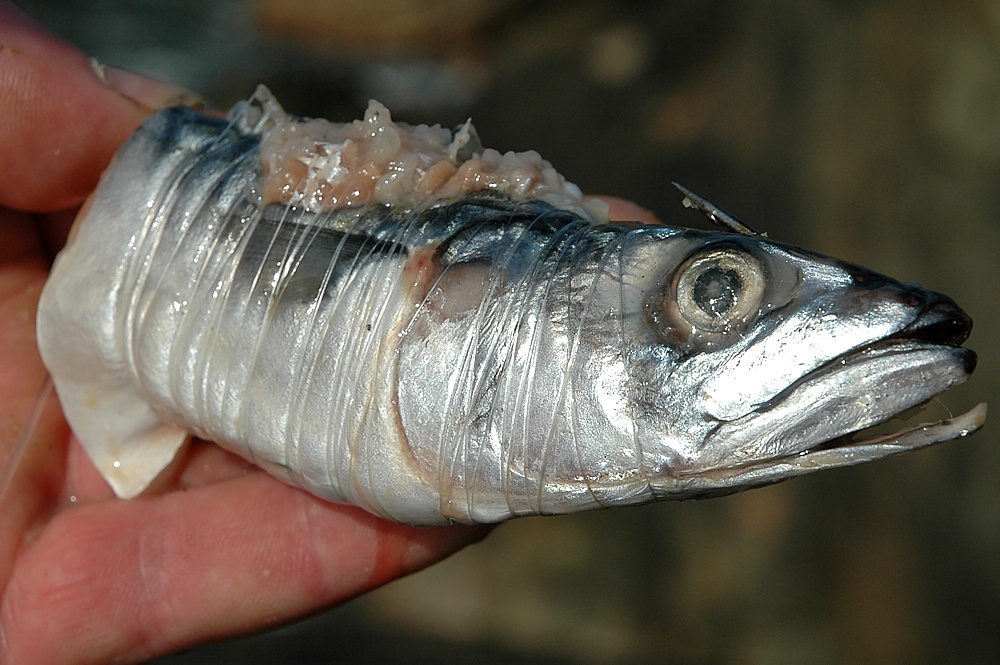
Method
If you’re on the stern of the boat, choose a lead weight light enough that you can lift it with the rod tip and then release a little line to keep trotting the bait further away from the boat. This achieves two things. Firstly, the bait is gradually further and further away from the other angler’s baits, and a bait on its own has a far greater chance of being picked up. Furthermore, a moving bait is always more attractive to tope than a static one.
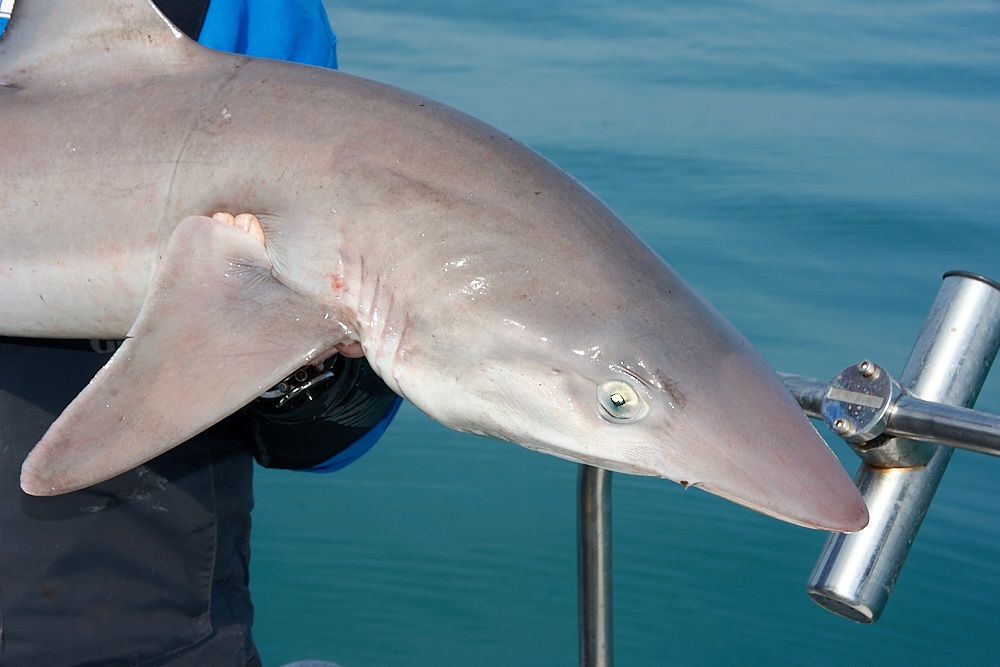
When you’re fishing from the side of the boat or up near the cabin, it’s best to cast away and uptide from the boat and release a little line as the weight hits the seabed to form a bow in the line and pull the weight in like an anchor. Casting away from the boat again puts your bait out on its own, but casting also allows you to search the ground you have available and in doing this you’ll identify little areas that seem to produce more bites, such as a depression in the ground, a patch of rough stones or boulders, or some other feature.
If you’re having to fish from the gunnels of the boat or near the cabin, change baits every ten minutes or so. A fresh bait oozing fresh juices has a far better chance of attracting a tope than a stale, washed out bait can.
Always have the drag on the reel set so that a big fish can easily take line under light, controlled pressure. If the fish feels undue pressure, it can drop the bait in the initial stages of the first run and won’t return. Being a pack or group fish, a tope will pick up the bait then rush away from other fish. As its run slows, it will then turn the bait to swallow it and move away again. If you hit the fish as it is slowing to swallow the bait or just as it starts to power away a second time, then most of your fish will be hooked in the front jaw or in the scissors.
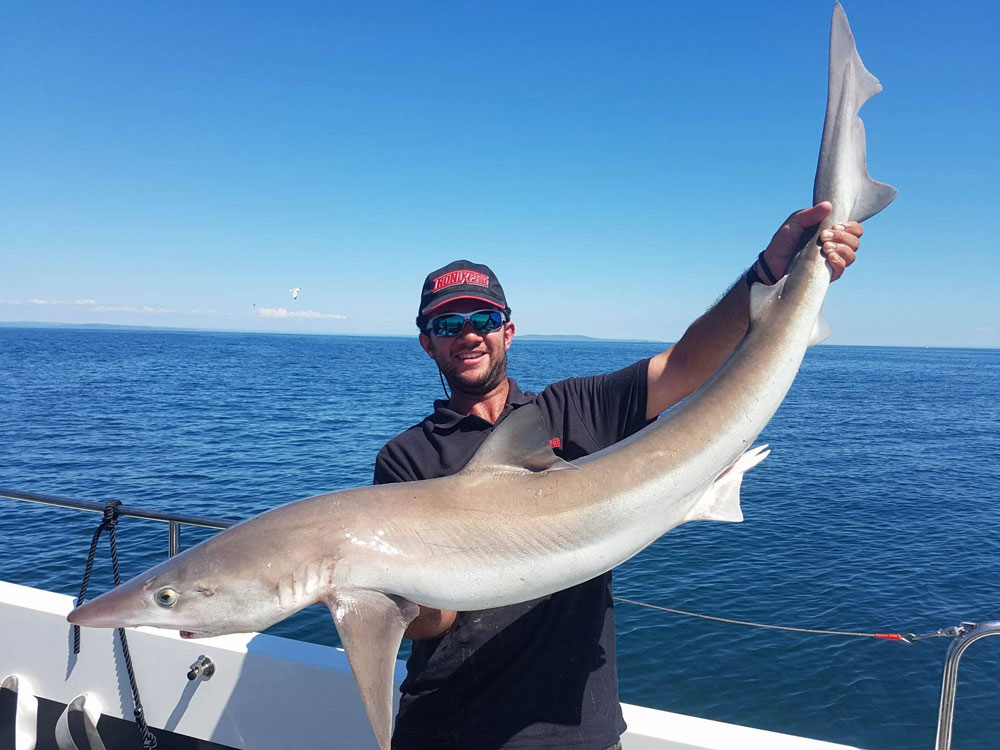
If a tope does drop the bait, then don’t move it, just leave it there. Anglers think that the fish will come back for it, but more likely is that another fish originally chasing the fish with the bait will pick up the bait and claim it for its own.
Male pack tope fight using fast surges, dragging small amounts of line from the spool. Bigger tope use their power to run at medium speed, but then hang in the water column. When a big fish hangs, always be prepared for a slow steady run again for the seabed, so have the reel drag adjusted ready.


